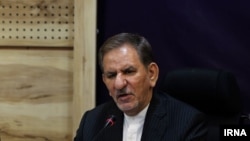Iran’s vice president Es’haq Jahangiri says that as a result of a “plot by the United States, Israel and Saudi Arabia” his country’s oil revenues dropped from $100 billion a year to nine billion in 2019.
Jahangiri did not specify when Iran’s annual oil exports amounted to $100 billion, but according to OPEC data in 2011 and 2012 it exported more than $100 billion dollars of oil before international nuclear sanctions came into full force.
Speaking on June 13 in Tehran, Jahangiri said that the U.S., Saudi Arabia and Israel joined forces to impose sanctions on Iran, probably referring to later sanctions by the United States.
President Donald Trump pulled out of an agreement with Iran aimed at freezing its nuclear activities in May 2018 and decided to reimpose sanctions on the country’s exports and banking sectors, demanding that Tehran either renegotiate the deal or face economic ruin. Iran rejected any compromise and the sanctions have gotten only tougher since then.
Meanwhile, the chief of Iran’s Central Bank, Abdolnasser Hemmati announced June 12 that between 2004 and 2019 Iran pumped $280 billion dollars into the local currency exchange market to defend the value of its rial. This is close to one-third of the money Iran earned from oil exports in this time period, which totaled around $950 billion.
The policy of defending the local currency completely failed as the rial dropped eighteen-fold from 2004 to its current value of 180,000 to the dollar. Before the Islamic revolution 70 rials bought one U.S. dollar. That is a 2500-fold drop, which hard to imagine, except in relatively rare cases such as Zimbabwe or Venezuela.
Hemmati himself acknowledged that a substantial part of the $280 billion spent to prop up the rial simply left the country. Citizens losing confidence in the system and government insiders who made a lot of profits using their privileged positions took their capital out of the country.
Vice president Jahangiri made passing remark about the economic hardship people face, but blamed it on U.S. sanctions, which is the commonly used argument by all Iranian officials.
However, some experts in Iran sometimes dare to allude to the country’s foreign policy as the main culprit for the economic crisis.
In an interview with a local website, Farau, published June 14, Iran-based economist Mahmoud Jamsaz said that the huge drop in the value of the rial was the result “of our weak foreign policy and our obsession with looking for enemies”.
This was a little-veiled reference to Supreme Leader Ali Khamenei’s policies. He has pursued an uncompromising anti-U.S. ideology since assuming power in 1989. This coupled with an extensive nuclear program and a quest for expanding the regime’s influence in the Middle East and building ballistic missiles have left little chance for normal relations with neighbors and the West.
The other side of the coin is the Islamic Republic’s economic system, which is a strange hybrid of government ownership and control over the economy with limited private ownership, and a high degree of resistance to open up its markets to safe foreign investments.
While other oil exporters have tried to diversify their economies, Iran has remained uncompetitive in most sectors, relying on dubious homegrown technologies that eat up a lot of resources. An open economy would have given the country a better chance of obtaining advanced technologies and foreign investments. Instead, it is an economy based on a model similar to insider trading. Military and political elites who have monopolized large segments of the economy compete for government resources, mostly generated by oil exports.






